Analysis of CommBank's Code of Conduct and Business Ethics
VerifiedAdded on 2023/06/05
|6
|1104
|487
Report
AI Summary
This report provides a detailed analysis of the Commonwealth Bank of Australia's (CommBank) code of conduct and business ethics. The introduction highlights the importance of a strong ethical framework within the financial industry, especially for a major institution like CommBank. The report examines key aspects of the code of conduct, including policies on discrimination, exploitation, corruption, dishonest and fraudulent behavior, and whistleblower protection. It provides definitions, real-world examples, and the bank's responses to ethical challenges. The report also explores the vision of CommBank and the importance of enforcement. References to relevant literature are included to support the analysis. The report emphasizes the significance of ethical practices for the bank's stakeholders and overall success.
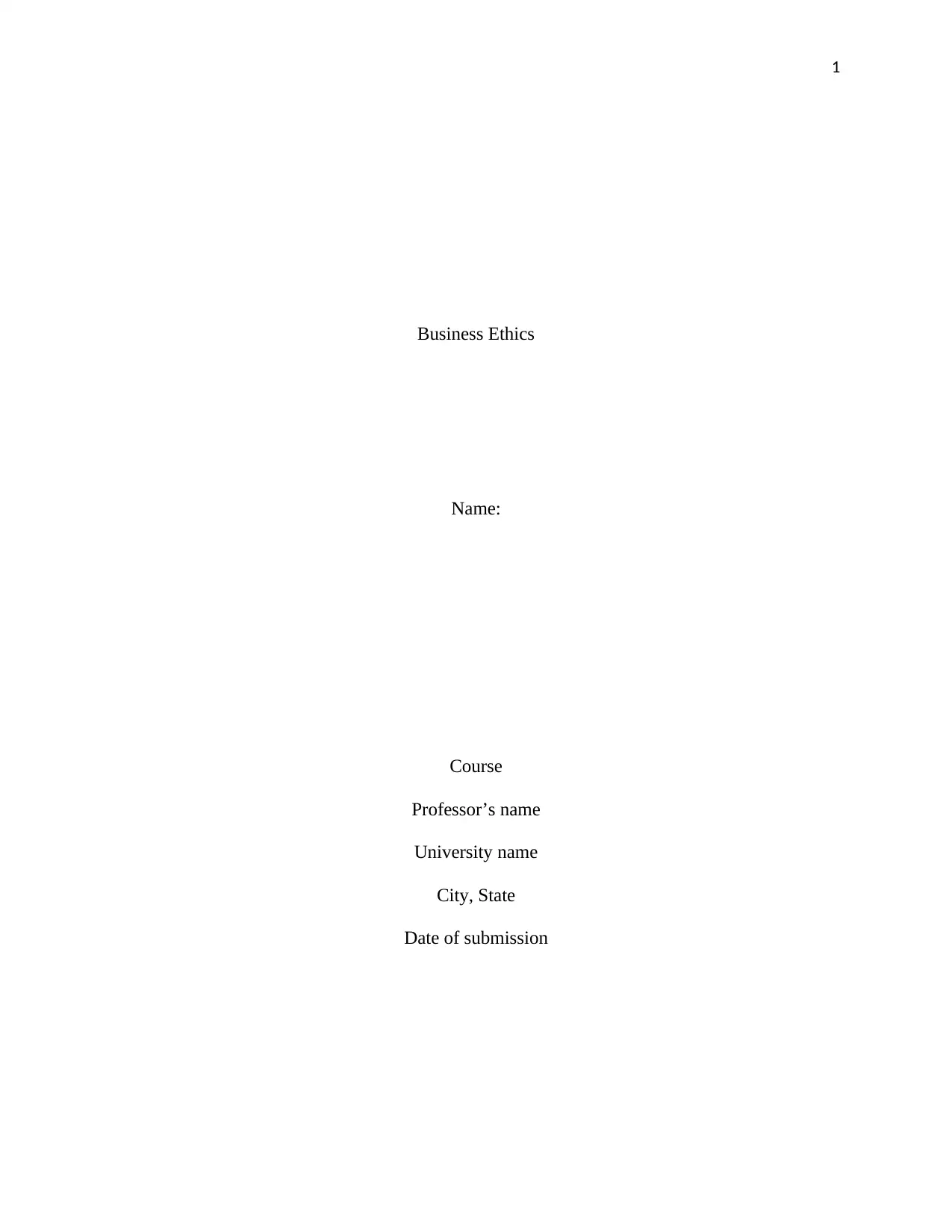
1
Business Ethics
Name:
Course
Professor’s name
University name
City, State
Date of submission
Business Ethics
Name:
Course
Professor’s name
University name
City, State
Date of submission
Paraphrase This Document
Need a fresh take? Get an instant paraphrase of this document with our AI Paraphraser
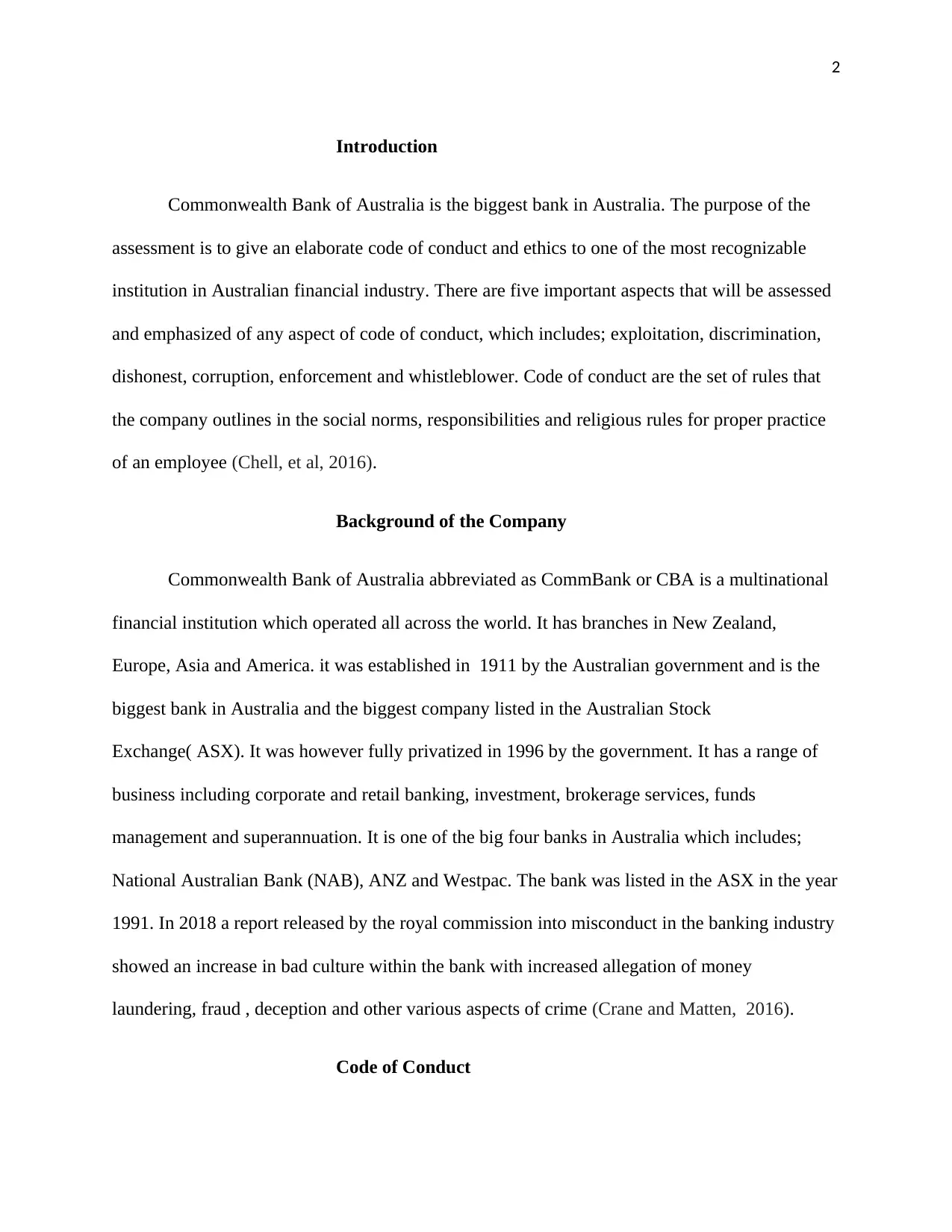
2
Introduction
Commonwealth Bank of Australia is the biggest bank in Australia. The purpose of the
assessment is to give an elaborate code of conduct and ethics to one of the most recognizable
institution in Australian financial industry. There are five important aspects that will be assessed
and emphasized of any aspect of code of conduct, which includes; exploitation, discrimination,
dishonest, corruption, enforcement and whistleblower. Code of conduct are the set of rules that
the company outlines in the social norms, responsibilities and religious rules for proper practice
of an employee (Chell, et al, 2016).
Background of the Company
Commonwealth Bank of Australia abbreviated as CommBank or CBA is a multinational
financial institution which operated all across the world. It has branches in New Zealand,
Europe, Asia and America. it was established in 1911 by the Australian government and is the
biggest bank in Australia and the biggest company listed in the Australian Stock
Exchange( ASX). It was however fully privatized in 1996 by the government. It has a range of
business including corporate and retail banking, investment, brokerage services, funds
management and superannuation. It is one of the big four banks in Australia which includes;
National Australian Bank (NAB), ANZ and Westpac. The bank was listed in the ASX in the year
1991. In 2018 a report released by the royal commission into misconduct in the banking industry
showed an increase in bad culture within the bank with increased allegation of money
laundering, fraud , deception and other various aspects of crime (Crane and Matten, 2016).
Code of Conduct
Introduction
Commonwealth Bank of Australia is the biggest bank in Australia. The purpose of the
assessment is to give an elaborate code of conduct and ethics to one of the most recognizable
institution in Australian financial industry. There are five important aspects that will be assessed
and emphasized of any aspect of code of conduct, which includes; exploitation, discrimination,
dishonest, corruption, enforcement and whistleblower. Code of conduct are the set of rules that
the company outlines in the social norms, responsibilities and religious rules for proper practice
of an employee (Chell, et al, 2016).
Background of the Company
Commonwealth Bank of Australia abbreviated as CommBank or CBA is a multinational
financial institution which operated all across the world. It has branches in New Zealand,
Europe, Asia and America. it was established in 1911 by the Australian government and is the
biggest bank in Australia and the biggest company listed in the Australian Stock
Exchange( ASX). It was however fully privatized in 1996 by the government. It has a range of
business including corporate and retail banking, investment, brokerage services, funds
management and superannuation. It is one of the big four banks in Australia which includes;
National Australian Bank (NAB), ANZ and Westpac. The bank was listed in the ASX in the year
1991. In 2018 a report released by the royal commission into misconduct in the banking industry
showed an increase in bad culture within the bank with increased allegation of money
laundering, fraud , deception and other various aspects of crime (Crane and Matten, 2016).
Code of Conduct

3
This is the pillar for the sensitive and operational activities involving the commonwealth
bank of Australia. It is important to build a simple, clear and easy code of conduct which follows
the banks mission, vision and values. It must be able to handle all the stakeholders involved with
the bank from the directors, managers, employees and suppliers. These are the most important
audience to the matter (Ferrell, and Fraedrich, 2015).
Vision
To excel in securing and enhancing the well-being of people financially, communities and
businesses underpinned by the company’s integrity, excellence, accountability, service and
collaboration.
A. Discrimination
Based on the definition by the Australian Human Rights Commission (AHRC), a discriminatory
incident occurs when a person or a group is discriminated based on their inclination to a specific
background like religion, sex orientation or any other distinctions. One may be in disadvantage
for this. The bank must have a clear policy on discrimination and illustrate how to deal with any
discriminatory action provided occurring in the bank. A notable incident of discrimination was
when the head of finance accused the bank of discrimination based on his age and sex. The
operations head Marshall was 60 years and lost the job to an Australian lady who was 13 years
his younger and it was against his will. For avoidance of further issues, CommBank established a
policy that no discrimination based on sexuality or age will be tolerated. Bullying and
This is the pillar for the sensitive and operational activities involving the commonwealth
bank of Australia. It is important to build a simple, clear and easy code of conduct which follows
the banks mission, vision and values. It must be able to handle all the stakeholders involved with
the bank from the directors, managers, employees and suppliers. These are the most important
audience to the matter (Ferrell, and Fraedrich, 2015).
Vision
To excel in securing and enhancing the well-being of people financially, communities and
businesses underpinned by the company’s integrity, excellence, accountability, service and
collaboration.
A. Discrimination
Based on the definition by the Australian Human Rights Commission (AHRC), a discriminatory
incident occurs when a person or a group is discriminated based on their inclination to a specific
background like religion, sex orientation or any other distinctions. One may be in disadvantage
for this. The bank must have a clear policy on discrimination and illustrate how to deal with any
discriminatory action provided occurring in the bank. A notable incident of discrimination was
when the head of finance accused the bank of discrimination based on his age and sex. The
operations head Marshall was 60 years and lost the job to an Australian lady who was 13 years
his younger and it was against his will. For avoidance of further issues, CommBank established a
policy that no discrimination based on sexuality or age will be tolerated. Bullying and
⊘ This is a preview!⊘
Do you want full access?
Subscribe today to unlock all pages.

Trusted by 1+ million students worldwide
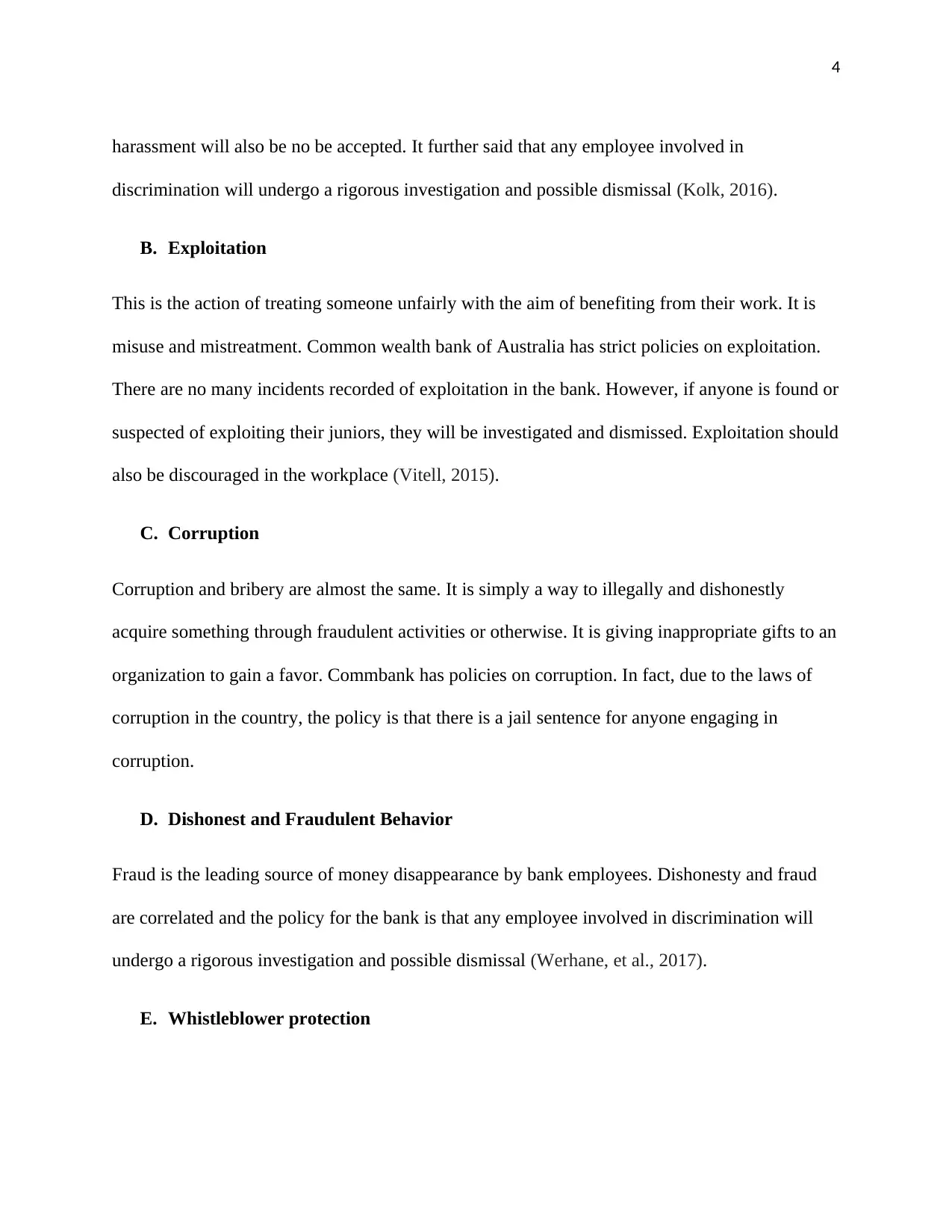
4
harassment will also be no be accepted. It further said that any employee involved in
discrimination will undergo a rigorous investigation and possible dismissal (Kolk, 2016).
B. Exploitation
This is the action of treating someone unfairly with the aim of benefiting from their work. It is
misuse and mistreatment. Common wealth bank of Australia has strict policies on exploitation.
There are no many incidents recorded of exploitation in the bank. However, if anyone is found or
suspected of exploiting their juniors, they will be investigated and dismissed. Exploitation should
also be discouraged in the workplace (Vitell, 2015).
C. Corruption
Corruption and bribery are almost the same. It is simply a way to illegally and dishonestly
acquire something through fraudulent activities or otherwise. It is giving inappropriate gifts to an
organization to gain a favor. Commbank has policies on corruption. In fact, due to the laws of
corruption in the country, the policy is that there is a jail sentence for anyone engaging in
corruption.
D. Dishonest and Fraudulent Behavior
Fraud is the leading source of money disappearance by bank employees. Dishonesty and fraud
are correlated and the policy for the bank is that any employee involved in discrimination will
undergo a rigorous investigation and possible dismissal (Werhane, et al., 2017).
E. Whistleblower protection
harassment will also be no be accepted. It further said that any employee involved in
discrimination will undergo a rigorous investigation and possible dismissal (Kolk, 2016).
B. Exploitation
This is the action of treating someone unfairly with the aim of benefiting from their work. It is
misuse and mistreatment. Common wealth bank of Australia has strict policies on exploitation.
There are no many incidents recorded of exploitation in the bank. However, if anyone is found or
suspected of exploiting their juniors, they will be investigated and dismissed. Exploitation should
also be discouraged in the workplace (Vitell, 2015).
C. Corruption
Corruption and bribery are almost the same. It is simply a way to illegally and dishonestly
acquire something through fraudulent activities or otherwise. It is giving inappropriate gifts to an
organization to gain a favor. Commbank has policies on corruption. In fact, due to the laws of
corruption in the country, the policy is that there is a jail sentence for anyone engaging in
corruption.
D. Dishonest and Fraudulent Behavior
Fraud is the leading source of money disappearance by bank employees. Dishonesty and fraud
are correlated and the policy for the bank is that any employee involved in discrimination will
undergo a rigorous investigation and possible dismissal (Werhane, et al., 2017).
E. Whistleblower protection
Paraphrase This Document
Need a fresh take? Get an instant paraphrase of this document with our AI Paraphraser
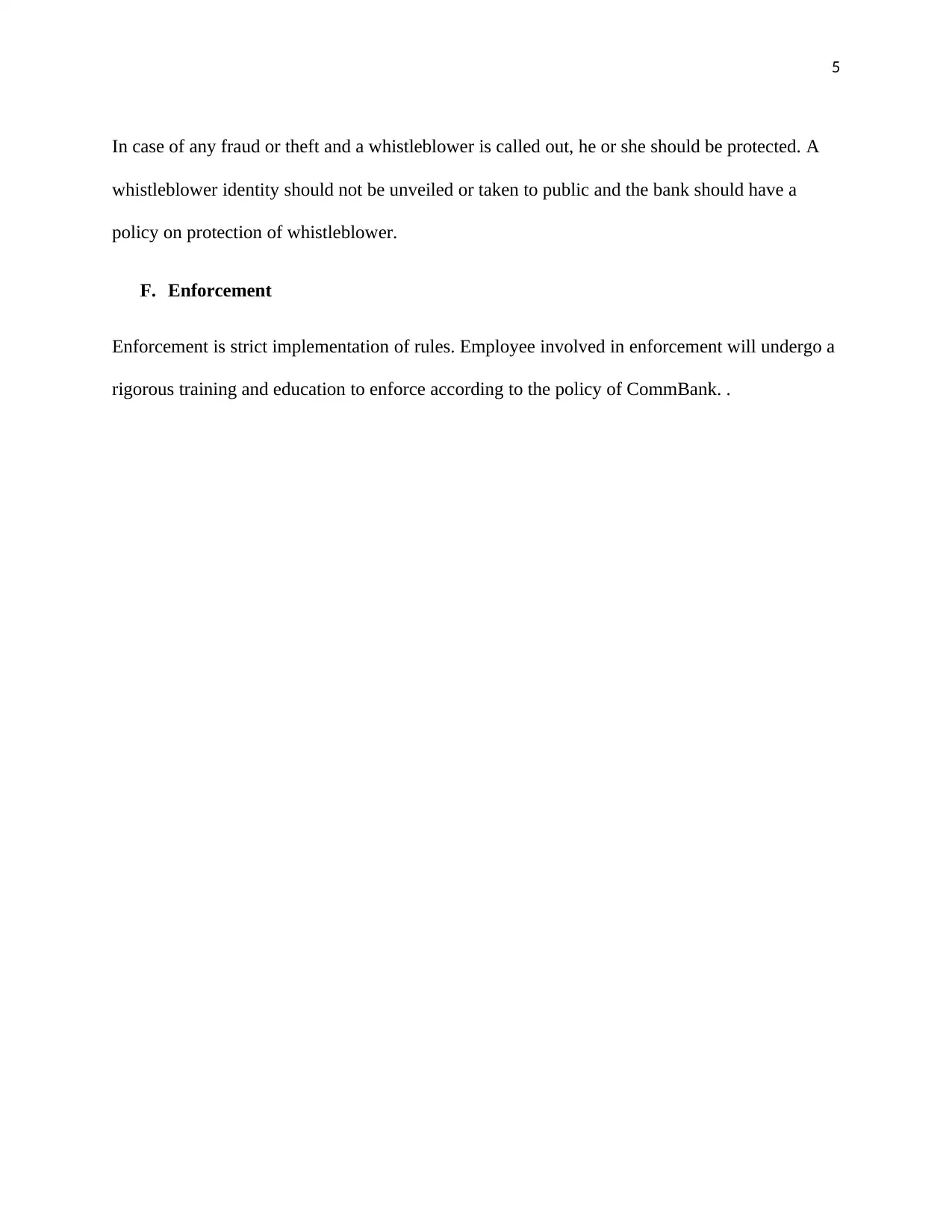
5
In case of any fraud or theft and a whistleblower is called out, he or she should be protected. A
whistleblower identity should not be unveiled or taken to public and the bank should have a
policy on protection of whistleblower.
F. Enforcement
Enforcement is strict implementation of rules. Employee involved in enforcement will undergo a
rigorous training and education to enforce according to the policy of CommBank. .
In case of any fraud or theft and a whistleblower is called out, he or she should be protected. A
whistleblower identity should not be unveiled or taken to public and the bank should have a
policy on protection of whistleblower.
F. Enforcement
Enforcement is strict implementation of rules. Employee involved in enforcement will undergo a
rigorous training and education to enforce according to the policy of CommBank. .
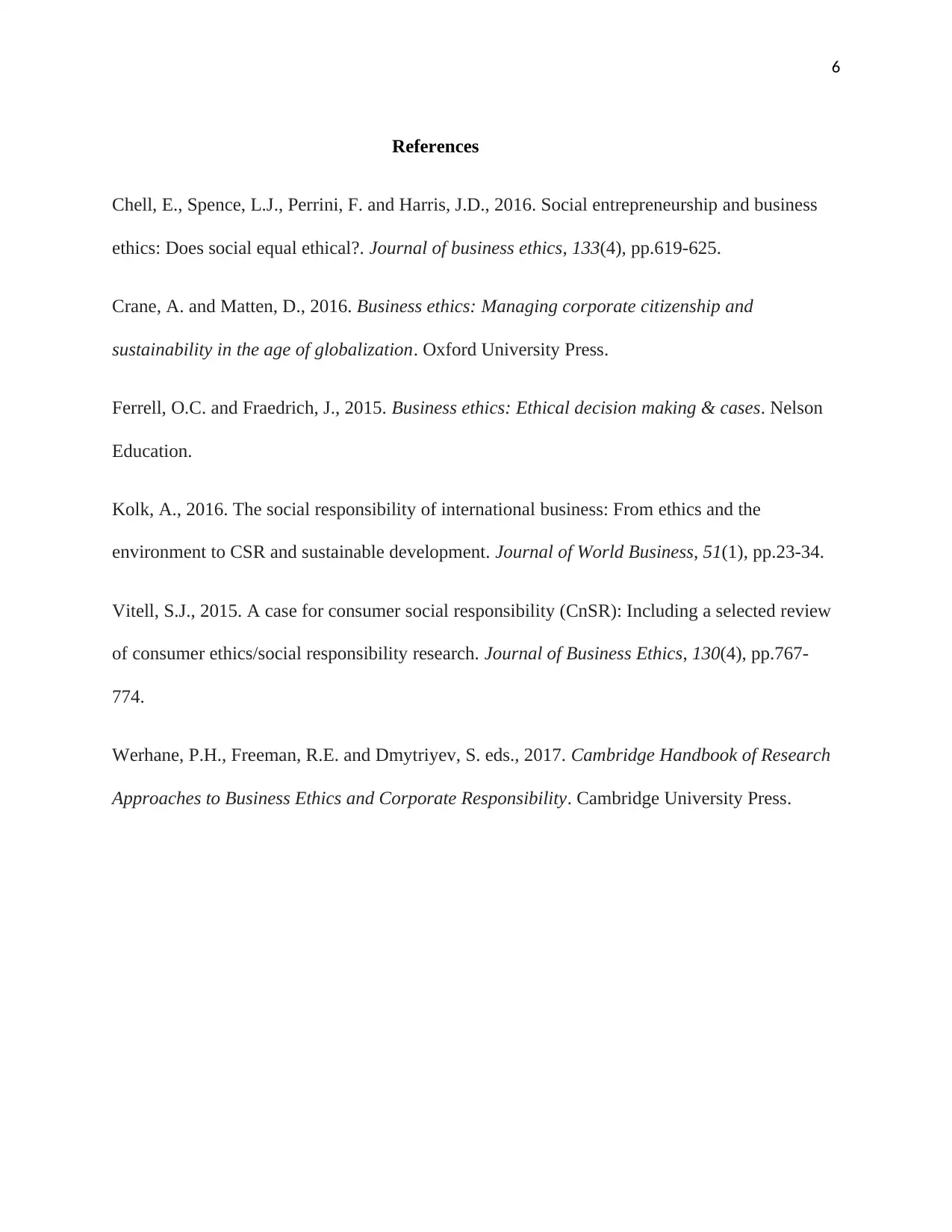
6
References
Chell, E., Spence, L.J., Perrini, F. and Harris, J.D., 2016. Social entrepreneurship and business
ethics: Does social equal ethical?. Journal of business ethics, 133(4), pp.619-625.
Crane, A. and Matten, D., 2016. Business ethics: Managing corporate citizenship and
sustainability in the age of globalization. Oxford University Press.
Ferrell, O.C. and Fraedrich, J., 2015. Business ethics: Ethical decision making & cases. Nelson
Education.
Kolk, A., 2016. The social responsibility of international business: From ethics and the
environment to CSR and sustainable development. Journal of World Business, 51(1), pp.23-34.
Vitell, S.J., 2015. A case for consumer social responsibility (CnSR): Including a selected review
of consumer ethics/social responsibility research. Journal of Business Ethics, 130(4), pp.767-
774.
Werhane, P.H., Freeman, R.E. and Dmytriyev, S. eds., 2017. Cambridge Handbook of Research
Approaches to Business Ethics and Corporate Responsibility. Cambridge University Press.
References
Chell, E., Spence, L.J., Perrini, F. and Harris, J.D., 2016. Social entrepreneurship and business
ethics: Does social equal ethical?. Journal of business ethics, 133(4), pp.619-625.
Crane, A. and Matten, D., 2016. Business ethics: Managing corporate citizenship and
sustainability in the age of globalization. Oxford University Press.
Ferrell, O.C. and Fraedrich, J., 2015. Business ethics: Ethical decision making & cases. Nelson
Education.
Kolk, A., 2016. The social responsibility of international business: From ethics and the
environment to CSR and sustainable development. Journal of World Business, 51(1), pp.23-34.
Vitell, S.J., 2015. A case for consumer social responsibility (CnSR): Including a selected review
of consumer ethics/social responsibility research. Journal of Business Ethics, 130(4), pp.767-
774.
Werhane, P.H., Freeman, R.E. and Dmytriyev, S. eds., 2017. Cambridge Handbook of Research
Approaches to Business Ethics and Corporate Responsibility. Cambridge University Press.
⊘ This is a preview!⊘
Do you want full access?
Subscribe today to unlock all pages.

Trusted by 1+ million students worldwide
1 out of 6
Related Documents
Your All-in-One AI-Powered Toolkit for Academic Success.
+13062052269
info@desklib.com
Available 24*7 on WhatsApp / Email
![[object Object]](/_next/static/media/star-bottom.7253800d.svg)
Unlock your academic potential
Copyright © 2020–2025 A2Z Services. All Rights Reserved. Developed and managed by ZUCOL.



